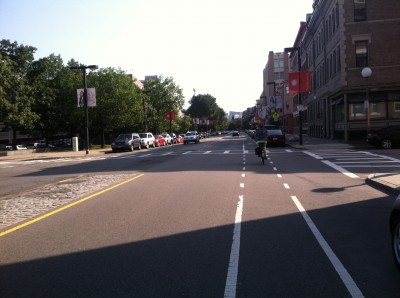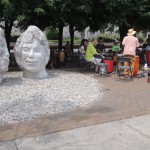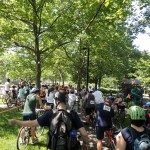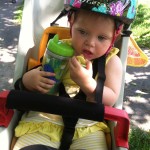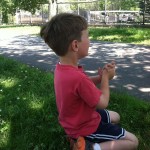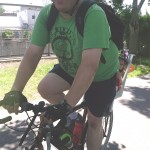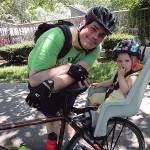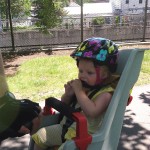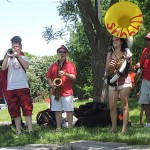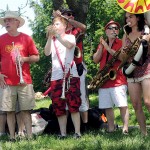Earlier this month, with no warning to the local bicycle community, the City of Boston Parks and Recreation department painted stencils prohibiting bike riders from riding on Boston Common’s pathways. A spokesperson for Parks and Recreation claimed that they were merely replacing signage that had faded away and that this restriction has always been in place, although no one seems to have a living memory of such restrictions being enforced. Others have commented that bicycle riding is a hazard to pedestrians in the park (an idea with some merit that we’ll return to later). All in all, this sudden change of policy is a black eye on the city which had been making great strides in improving conditions for cyclists (a bike czar, new bike lanes, Hubway, et al).
One can imagine the outrage among motorists if one morning they learned they were no longer allowed to drive on James Jackson Storrow’s Embankment, along Frederic Law Olmsted’s Riverway/Jamaicaway, or right through the heart of Olmsted’s Franklin Park (to name three city parks where motor vehicles are currently allowed to travel at high speeds/high volume and are a threat to pedestrian activity). Boston Common is a special park with a long history and it’s very name endorses a shared space. For recreational bicycling, Boston Common is really the only safe space downtown where people of all ages and abilities can enjoy a bike ride.
But the Common is also important for commuter bicycling. It sits at the crossroads among many neighborhoods – the Financial District, Downtown Crossing, Chinatown, Back Bay, and Beacon Hill. Bike riders coming from the Longfellow Bridge and the Charles River bike paths cross the Common to reach downtown offices. Without access to the Common, the options are grim. Boston Common and the Public Garden are surrounded by roads that are geared to heavy automotive traffic – four lanes wide, one way, and not at all welcoming to cyclists. Even the City’s Bike Routes of Boston Map rates the roads surrounding the Common/Garden as “Advanced – Suitable for experienced and traffic-confident riders … Traffic volumes and/or speeds can be high. Intersections might be complex.” Stretches of Tremont St. and Charles St. are rated intermediate, but to be honest as an experienced bike commuter I find these roads just as challenging. With the Common closed to bike traffic, we can expect to see a reduction in bike commuting and increase in motor vehicles.
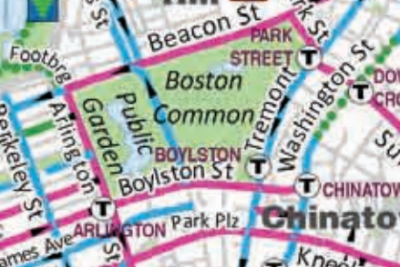
Detail of “Bike Routes of Boston” Map, where pink = DANGER!!!
As I mentioned, there is some validity to concerns that bicycle traffic through a public park is irritating or even dangerous to other users on foot. I certainly would like to see better behavior on the part of all cyclists. Still, a complete banishment seems extreme, when a more moderate solution is easy to come by. Several of the pathways in Boston Common are very wide and could accommodate both bikes and pedestrians. In fact, other parks in Boston such as the Riverway and Southwest Corridor have bike and walking paths parallel to one another (and I have to mention that people are always walking and jogging on the bike paths, so apparently they feel less threatened by bikes in these parts of town). A little paint on Boston Common pathways can designate where bikes are permitted and where they are prohibited. Enforcement will be a challenge, but that will be a problem with trying to keep bike riders out of Boston Common as well. I like to think positively of human nature that if given a place to ride, the vast majority of bike riders will keep out of the parts of the park that are restricted. Below, I’ve mapped out a route on some of Boston Common’s widest pathways that will make convenient connections for bike commuters on the periphery while maintaining the heart of the park for other recreational uses.

There’s a lot of Common to go around, we can share!
Of course, a better alternative to everyone would be to keep bicycles out of the Common entirely by building protected, two-way bike lanes on the roads surrounding Boston Common and the Public Garden similar to the one enjoyed by Brooklyn bicyclists on Prospect Park West. Bicyclists would have safe and convenient routes around the heart of Boston. Other park users would not have any dangerous encounters with bikes. And by removing one travel lane on roads such as Tremont, Boylston, Charles, and Arlington Streets, the bike paths would have a calming effect on auto traffic reducing speeding, noise, and the risk of people being hit by cars. Ultimately, it would be a huge step in making Boston “a world-class bicycling city by creating safe and inviting conditions for all residents and visitors,” encouraging more bike commuters and reducing the numbers of cars.
On the map below I marked out routes in green on Tremont Street, Boylston Street, Charles Street, Beacon Street, and Arlington Street where Prospect Park West style protected on-street bike paths would run immediately adjacent to the parks.
I’ve also marked in blue three places where “spur” bike paths can connect the downtown Boston routes to other parts of the city and beyond. First, there’s Charles Street, a three-lane wide one-way road that is the main connection to the Longfellow Bridge and from there ultimately Cambridge, Charlestown, and beyond. A short second spur would connect the paths on Beacon and Arlington Streets to the Fiedler Footbridge and to the Charles River bike path, a major bike commuter “highway” to outlying neighborhoods and neighboring communities. Finally, from the corner of Boylston and Charles Streets, a spur that crosses a wide swath of sidewalk to connect to Park Place and ultimately to the bike lanes on Columbus Avenue and onward to the Southwest Corridor. While this would not be a large commitment to on-street bike paths in terms of mileage (1.75 miles for the green paths with an additional 1.25 miles for the blue spur paths), it would be a huge improvement to bike infrastructure in central Boston and something I think would spur a revolutionary change in bike commuting.

Downtown Boston’s protected on-street bike path network. Coming soon?
So what do you think? Are we going to take a step towards Boston future, or are we going to rehash the city’s anti-cycling past?


